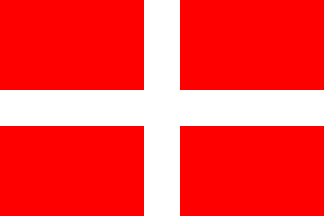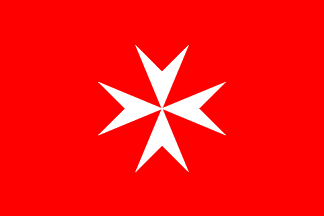
by Zeljko Heimer, 8 June 2002

Last modified: 2004-07-03 by dov gutterman
Keywords: malta | europe | s.m.o.m. | sovereign and military order of malta | knights hospitallers | order of st.john | jerusalem | rhodes | maltese cross | italy | rome | amalfi |
Links: FOTW homepage |
search |
disclaimer and copyright |
write us |
mirrors

Grand Master Flag
by Zeljko Heimer, 8 June 2002
See also:
Other Sites:
This humanitarian organization has agreed with the state of
Italy on a certain level of sovereignty in 1966, expressed mainly
in the issuing of stamps and coins. One should draw attention on
their stamps, since they are mostly heraldical and vexillological
(and history of art, but we are not dealing with that here?).
Most of the serious stamp dealers don't recognize those stamps to
be real stamps, but for vexi-freaks, they are quite interesting,
I dare say valuable source of (primarly) coats of arms. The Order
has its branches (missions) in many countries of the world, and
their stamps are recognized by 44 states (until 1994). However,
on some of the stamps there are images of the flag of the Order,
red with a white Maltese cross. On all the images the flag is
shown flying, so it is difficult to estimate the proportions. Is
seems to me that 1:2 is approximate enough.
Zeljko Heimer 8 March 1996
Extracts from the St John Ambulance Australia Cadet Manual
(3rd Edition) :
Seven years later [the Knights Hospitaller] were given the island
of Malta by the Emporer Charles V of Spain. ... The Order had
always contained people of different nationalities and was
organised into eight national 'Tongues', which were, in the
official order of precedence, those of Provence, Auvergne,
France, Italy, Aragon, England, Germany and Castile-Portugal.
The British occupation in 1800 (...) found the knights dispersed
and disunited. Subsequently, they established their headquarters
in Rome, where their claims to sovereign status are recognised by
more than thirty countries with which they maintain diplomatic
relations. This is exclusively a Roman Catholic and a religious
Order, known now as the Sovereign Military Order.
Jonathan Dixon 24 September 1999
SMOM is sovereign and has diplomatic ties with a number of
countries, but it has no territory except a few buildings used
for administration.
Ole Andersen, 14 March 2001
The Soveriegn Military Order of Malta is a sovereign entity
according to international law, but is acctualy used as a classic
example of an entity which is sovereign (like a country) but is
not a country. It does not have a territory, and therefore, it
does not live up to the requisites of a country. A sovereing
entity does not have to be a country. SMOM is an example of this.
For sovereignity, it is generally considered that the entity
should recogniced as such by other sovereign entities.
Literature on the subject: R.M.M. Wallace: "International
Law", Sweet & Maxwell, 2nd edition, London 1992, page 76
Elias Granqvist, 14 March 2001
The case of the SMOM is an interesting matter. Different books
on international law give different explanation. Some countries
consider it as a sovereign organization, others consider it as a
country without territory, others consider it as the world's
smallest country. Whether it is a country or not depends on the
status of the headquarters of SMOM (a building and a garden -
6000 square meters). The headquarters have an extraterritorial
status, but it is not clear whether it is the territory of the
SMOM or it is the embassy of SMOM in Italy. In any of the two
cases, I think that the SMOM should be considered as a country,
as it have many of the functions of a country: it has diplomatic
relations with many countries, issues passports (only countries,
the Red Cross, and the UN issue passports), and is member of a
few international organizations.
Ivan Marinov, 14 March 2001
I have at hand a book, "Report from Practically
Nowhere" by John Sack, copyright 1955 et seq., published by
the Curtis Publishing Company, with chapters about visits to
Andorra, San Marino, Lundy, Liechtenstein, Sharjah, Athos, Swat,
Punial, etc., with a chapter about the S.M.O.M. wherein is stated
that, by agreement with the Italian government, citizens of the
S.M.O.M. are limited to three: the Grand Master, the Deputy Grand
Master, and the Chancellor. These carry S.M.O.M.
passports. The numerous other members of the order remain
citizens of their own respective countries. Italian (or
other).
John Ayer, 14 March 2001
The case of SMOM is similar to the Vatican's case in this
sense. The Vatican also has citizens (1500
persons), but there is nobody with only Vatican citizenship. For
example, the Pope is citizen of both the Vatican and Poland. The
other peculiarity is that the Vatican issues only diplomatic
passports, so this is a country, where all the citizens are
diplomats. SMOM has the same practice. A month ago there was a
scandal in Hungary with the chief of the humanitarian service of
the Hungarian branch of the SMOM. In the news there was the
following information: he was beaten in Romania and both his
Hungarian and his SMOM diplomatic passport were stollen.
Maxval, 14 March 2001
According to <www.smom-za.org>,
SMOM has diplomatic relations with 75 countries. It also has
permanent observer status at the UN and Italian recognition of
its extraterritorial rights over its properties in Rome. Given
the humanitarian activities of the SMOM, I'd guess that the value
in having it recognized as a sovereign entity is that it can be
seen as neutral, allowing SMOM into a war zone or wherever
doesn't have to carry the political baggage it might have if SMOM
were a corporation operating under the laws of Italy, let alone
the United States, for example.
Joe McMillan, 15 March 2001
John Ayer made reference to a 1955 book by John Sack titled 'Report from Practically Nowhere.' I had a chance to read this book over the weekend, and while it's o